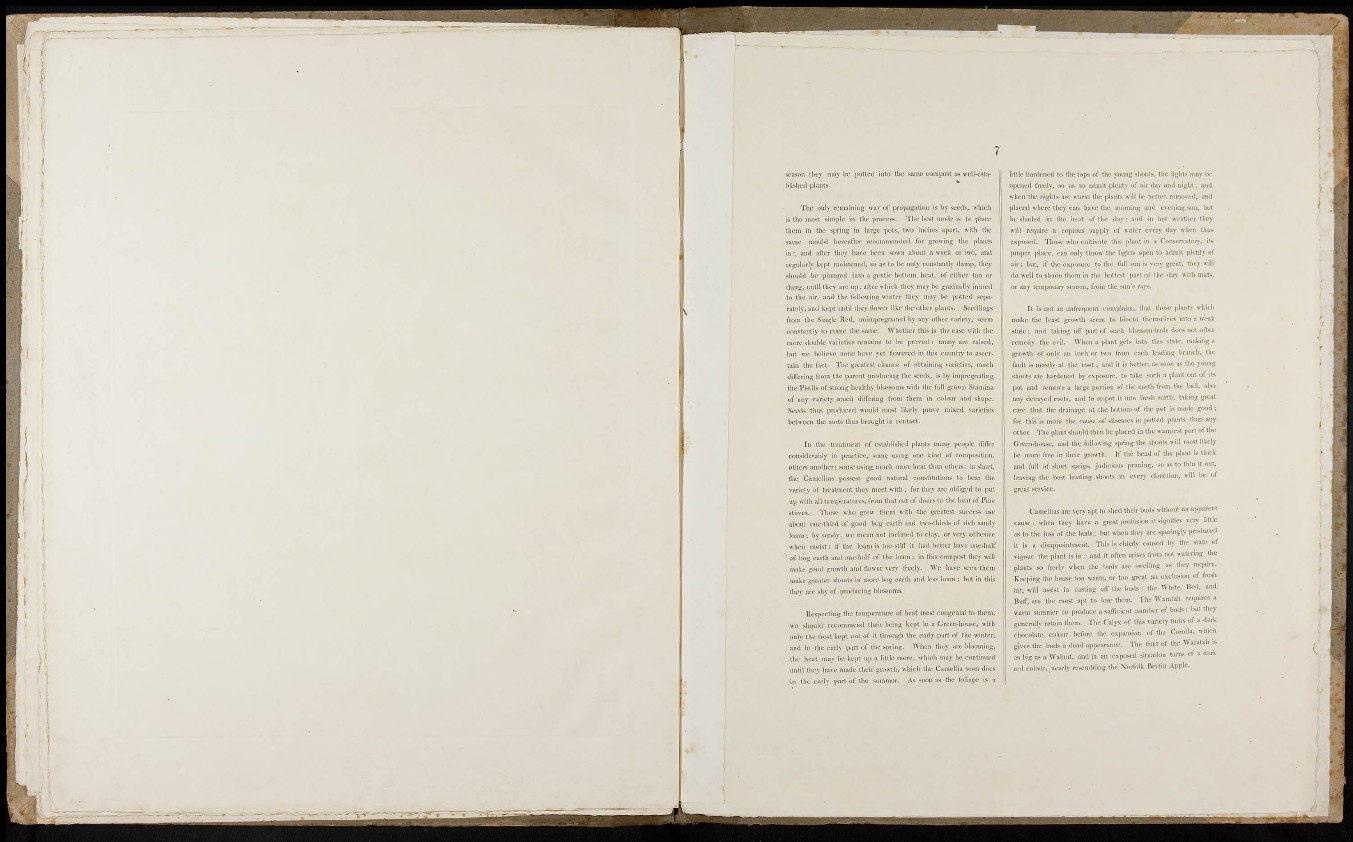
»
season tlic)- may be potled into the s:
Wished plants.
•iiipoBt as wcU-csta-
'I'he only veniainiiig way ol' propagation is by seeds, wliich
is the most simple in the process. The best mode is to plaee
tliem in the si>ring in large pots, Ivo inches apart, with the
same mould liereafter recommended for growing the ¡>lants
ill ; and alter they lia\x been sown about a «xck or two, and
regularly kept moistened, so as to be only constantly damji, they
should be plunged into a gentle bottom heat, of either tan or
dvmg, until they are up; after svhieh they may be gradually inured
to the air, and the following winter they may be potted separately,
and kept until they flower like the other plants. Seedlings
from the Single Red, niiimpregnated by any other variety, seem
constanlly to come the same. Whether this is the case witli the
more double varieties remains to be proved ; many are raised,
but we believe none have yet (lowered in this country to ascertain
the fact. The greatest chance of obtaining varieties, much
differing from the parent producing the seeds, is by impregnating
the Pistils of strong healthy blossoms with the full grown Stamina
of any variety much dlirering from them in colour and shape.
Seeds thus produced would most likely prove mixed varieties
between the sorts thus brought in contact.
In the treatment of established plants mauy people differ
considerably in practice, some using one kind of composition,
others another; some using nuich more heat than others: in short,
the Camellias (jossess good natural constitutions to bear the
variety of treatment tliey meet «'ith : for they are obliged lo put
up with all temperatures, from that oat of doors to the heat ol" Pine
stoves, Those who grow them with the greatest success use
about one-third of good bog earth and two-thirds of rich sandy
loam ; by sandy, we mean not inclined to clay, or ver)- ailhcsive
when moist: if tlie loam is too stiff it had better have one-luilf
• of bog earth and one-half of the loam ; in this compost they will
make good growth and llower very freely. ^Ve have seen them
make greater shoots in more bog earth and less loam ; but in this
they arc shy of producing blossoms.
Respecting the temperature of heat most congenial to them,
we should reconimcud their being kept in a Green-house, ^vith
only the frost kept out of it through the early part of the winter,
and in the early part of the spring. When they are blooming,
the heat may bo kept up a little more, «'tiich may be contiinie<i
until they have ma<le their growth, which the Camellia soon does
in the early l>art of the summer. As soon as the foliage is a
little hardened to the tops of the young shoots, the liglits may be
opened freely, so as to admit plenty of air day and night; and
when the nights arc warin the plants will be belter rcmoi'cd, and
placed where they can havi: the morning and evening sun, but
be shaded in the licat of tlic day; and in hot weather they
will re<|uirc a copious supply of water every day when thus
exposed. Those who cultivate this plant in a Conservatory, its
proper plaee, can only throw the lights open to admit plenty of
air ; but, if the exposure to the full sun is very great, they will
do well to shade them in the hottest part of the day with mats,
or any temporary screen, from the snn's rays.
It is not an unfrciii
make the least growth
;nt complaint,' that those plants which
weak
state ; and taking oli' part of such blossom-buds does not often
remedy the evil. When a plant gets into this state, making a
growth of only an inch or Iwo from each leading branch, the
fault is mostly at the i-oot; and it is better, as soon as the young
shoots are hardened by exposure, to take such a plant out of its
pot and remove a large portion of the earth from the ball, also
any decayed roots, and to re-pot it into fresh earth, taking great
care that the drainage at the bottom of the pot is made good ;
for this is moré the cause of diseases in i>otted plants than any
other. The plant should then be placed in the warmest part of the
Green-house, and the following spring the shoots will most likely
be more free in Iheir growth. If the head of the plant is thick
and full of short sprigs, judicious pruning, so as lo thin it out,
leaving the best leading shoots in every dii-ection, will be- of
great service.
Camellias arc very apt to shed their buds without an apparent
cause: when they have a great profusion it signifies very little
as to the loss of the buds; but when tlicy are sparingly produced
it is a disappointment- This is chiefly caused by the state of
; and it often arises from not watering the
buds are swelling as they require.
....n, or too gi-eat an exclusion of fresh
vigour the plant
plants so freely when
Keeping the
air. will ass
Buff, are th
casting off the l.ucis : the ^Vhite. Red, and
apt to lose them. The Wuratah requites a
¡0 produce a sufficient number of buds; but they
generally retain them. The Calyx of this variety turns of a dark
chocolate colour before llie ex|>ansion of the Corolla, which
gives the buds a dead appearance. The fruit of the ^Varatah is
as big as a Walnut, and in an exposed situation turns of a dark
red colour, .nearly resembling the Norfolk Beefin Apple.
i Í
Ì
I th